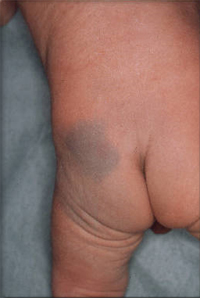|
Intermix.org.uk is a website for the benefit
of mixed-race families, individuals and anyone who feels they have a multiracial
identity and want to join us. Our mission is to offer a view of the mixed-race experience, highlighting icons, film, books, poetry, parenting techniques, celebrities, real lives and much more. Our online forums are a great place to meet others, ask questions, voice your opinions and keep in touch. Sign up for our monthly newsletter and delve into our pages. Want to join in? Become an Intermix member to take part: |
Mongolian Blue Spots
 These
birthmarks can sometimes be mistaken for bruises and raise questions
about child abuse. Put your mind at rest and learn what the health
professional should already know.
These
birthmarks can sometimes be mistaken for bruises and raise questions
about child abuse. Put your mind at rest and learn what the health
professional should already know.
Mongolian blue spots also known as congenital dermal melanocytosis are
flat bluish or bluish-gray skin markings that commonly appear on babies
at birth or shortly thereafter.
They are particularly common among darker-skinned children, such as Asian, African and those from mixed-race parentage.
The spots appear as dark blue lesions with
unclear borders and irregular shapes.
They can normally be found at the base of the spine, on the
buttocks and back but they have been known to appear on other areas
of the body such as the face and shoulders.
Occasionally, Mongolian blue spots are mistaken for bruises and questions
about child abuse arise. It is important to recognise that Mongolian
blue spots are birthmarks, NOT bruises.
Most health workers are now aware of the markings and
questions of child abuse should not arise. If they do then calmly
inform the health worker that you believe the markings to be Mongolian
blue spots but are happy for a doctor to verify that fact. Examination
of the skin is sufficient to determine that the marked areas are Mongolian
blue spots. No testing is necessary.
Mongolian spots are benign skin markings and are not associated with any conditions or illnesses. No treatment is necessary as they are not painful or dangerous. The bluish discoloration often fades in a few years and is almost always gone by adolescence.
You
don't have to go it alone, click here
to read how to build a support
network:
